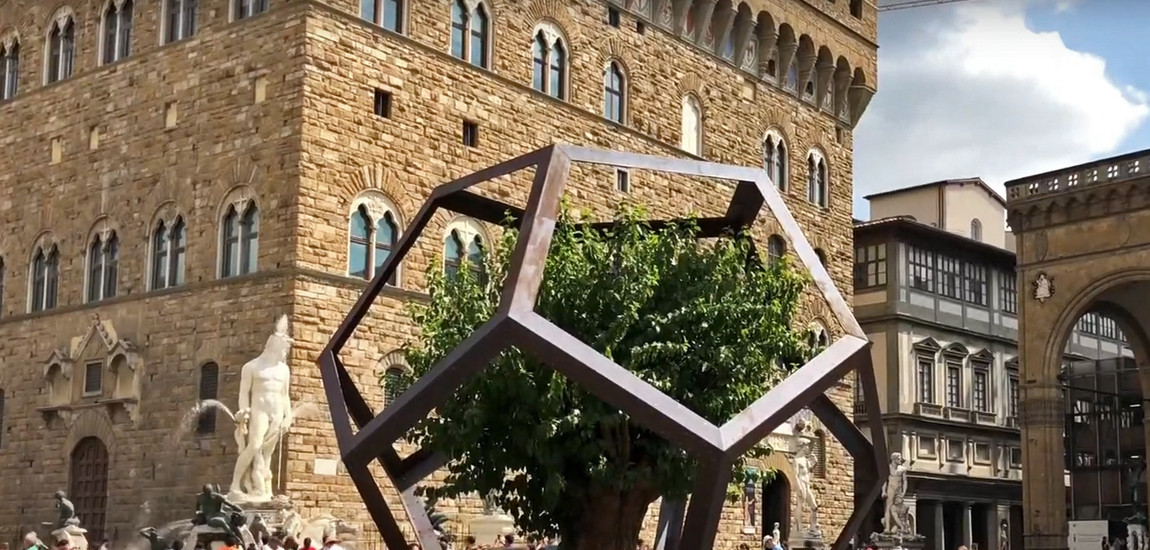
La Botanica di Leonardo in Florence
During the summer, strange structures appeared in Florentine squares: a dodecahedron in piazza della Signoria containing a mulberry tree, a hexahedron (or cube) in piazza Bambini di Beslan, a tetrahedron in Piazza Stazione and an icosahedron in Piazza Santa Maria Novella.
They are part of the exhibition that has opened yesterday to the public, La Botanica di Leonardo, set up in the complex of Santa Maria Novella, where Leonardo lived in the period during which he was working on the cardboard for the Battle of Anghiari.
The exhibition, curated by Florentine neurobiologist Stefano Mancuso, physicist and systems theorist Fritjof Capra, and founder of the pharmaceutical company Aboca, Valentino Mercati; is entirely dedicated to Leonardo's studies on botany. Avant-garde studies that are still of relevance today.
Although Leonardo is considered one of the most famous intellectuals in history, not much is known about his science.
Therefore,
this exhibition aims to put the focus on Leonardo’s science, in particular on
the numerous botanic studies conducted by the master. His writings allow us to know
Leonardo as a systemic thinker, capable of thinking in terms of connections,
relationships and context.
We discover a scientist with an ecological soul
and a huge respect for nature, which gives us the opportunity to reflect on
scientific evolution and environmental sustainability; a topic that has never
been as relevant as right now.
Through the study sheets on the form and structure
of plants exctracted from the Atlantic Codex of the Ambrosian library, we come
to understand how Leonardo was the first to discovered phyllotaxis, that is,
the way in which leaves arrange themselves on a branch; he observed how plants
move and discovered how much light and gravity are two very important factors
for the development of plants, already in the sixteenth century.
To accompany the folios of the Atlantic Codex on
display, there are also various specimens of plants, interactive installations,
videos and the spectacular polyhedrons that we have admired in the Florentine
squares.
In fact,
mathematical and geometric studies related to polyhedra can be found in
numerous manuscripts written by Leonardo. The master places particular
attention on their constructive processes and on their philosophical and cosmological
implications: in the past it was thought that each element was made up of
infinite particles with a specific geometric structure, corresponding to five
regular base solids.
These solids were designed in detail and with
perfect perspective by Leonardo da Vinci, in the treatise "De Divina
Proportione" by Luca Pacioli.
Earth, immobile and very stable, was associated
with the cube, or hexahedron, the most stable of all solids.
Fire was connected
to the tetrahedron, whose pyramidal shape recalls the flames that rise upwards.
Air was associated with the octahedron, whose form
expands upwards and downwards, like air does.
Water was linked to the icosahedron, a solid
composed of 20 triangular faces that allow for it to roll and move with
agility, just like water.
Finally, the quintessence was associated with the
dodecahedron, which for the ancient Greeks and Renaissance Neoplatonists,
represented the entire universe: “still
remaining a form of composition, which is the fifth, God had benefited from it
for the design of the 'universe."
One of Leonardo's most beloved plants, the
mulberry, is associated with the dodecahedron and placed inside it, to
represent the mystery of the connection among all things. It was this mystery
that fascinated Leonardo throughout his life and inspired his studies, which
have reached us to our days.
An unusual exhibition, which for once, does not
focus only on Leonardo da Vinci as a master painter, but on Leonardo as a great
man of science.



